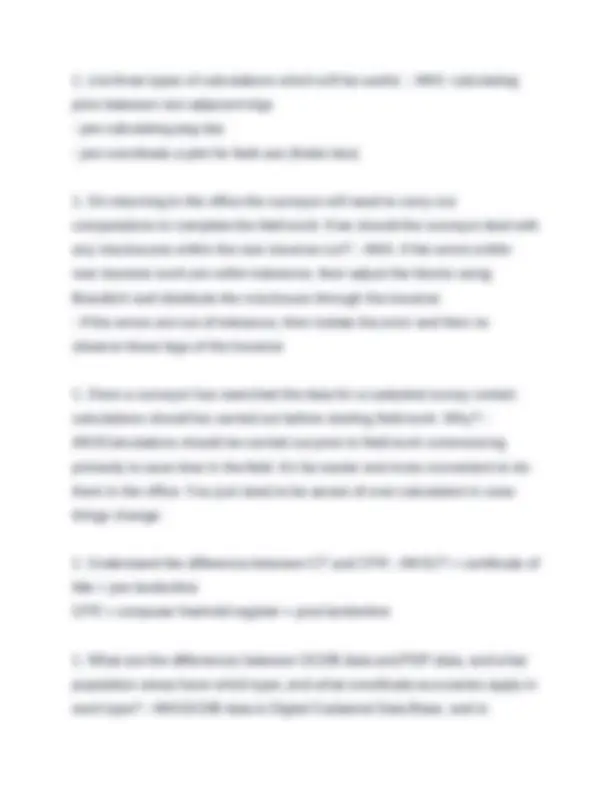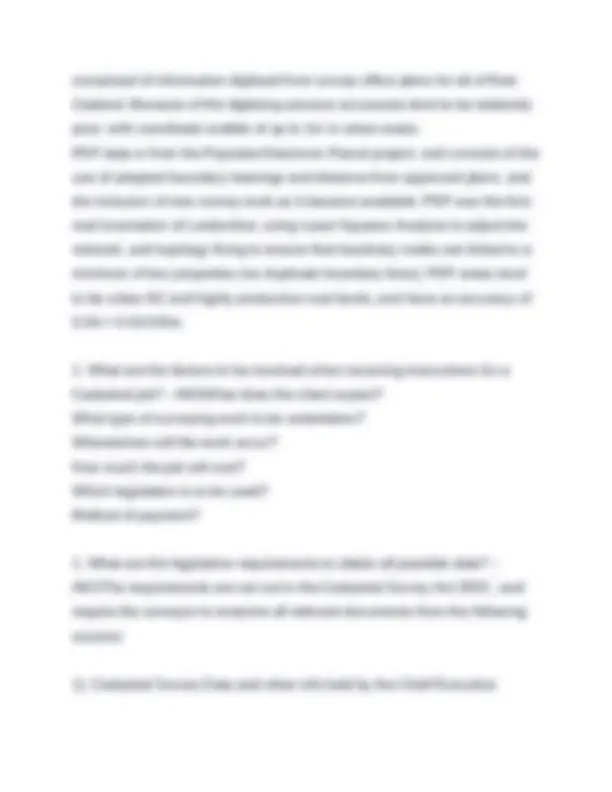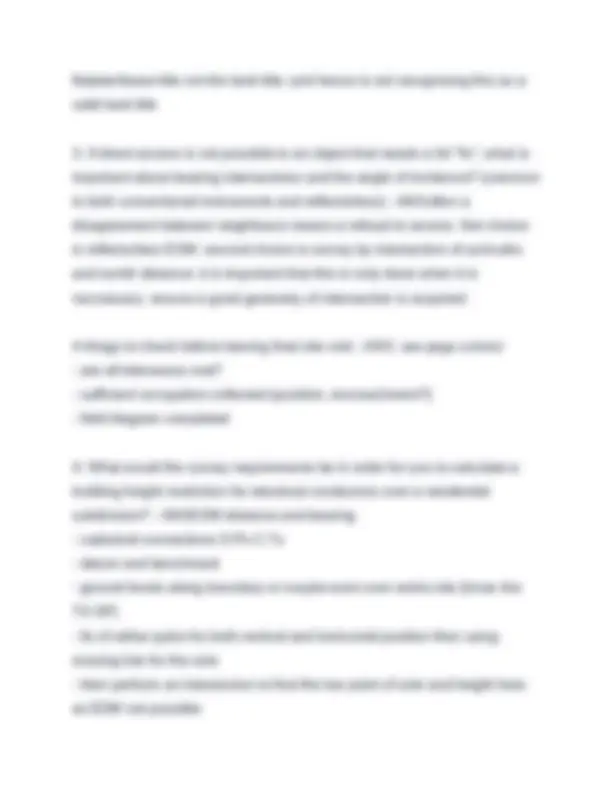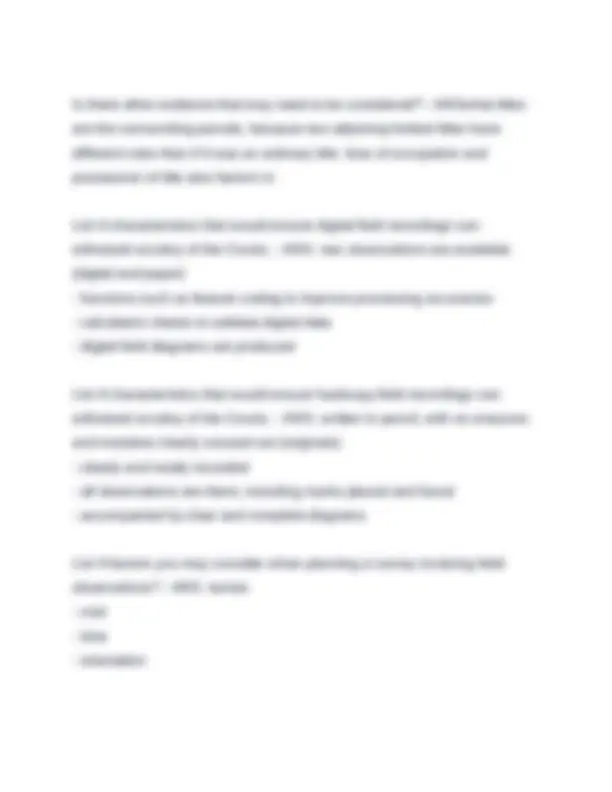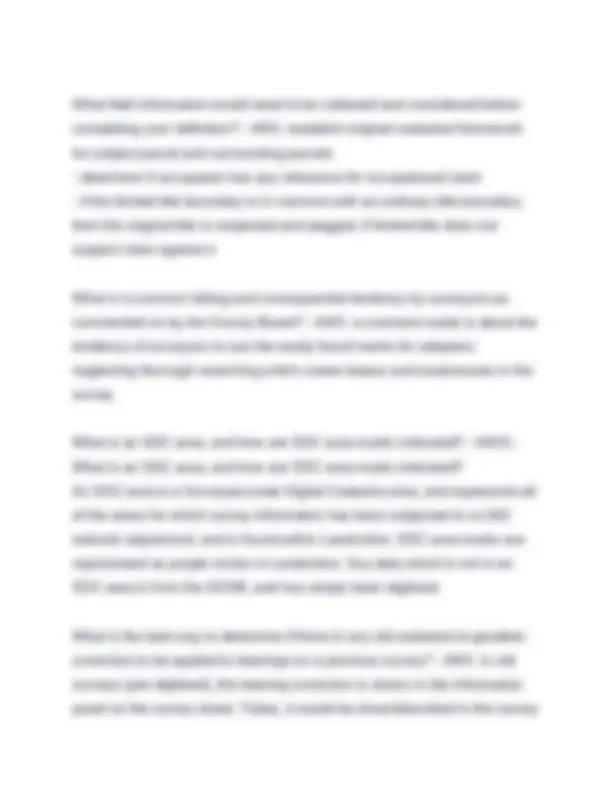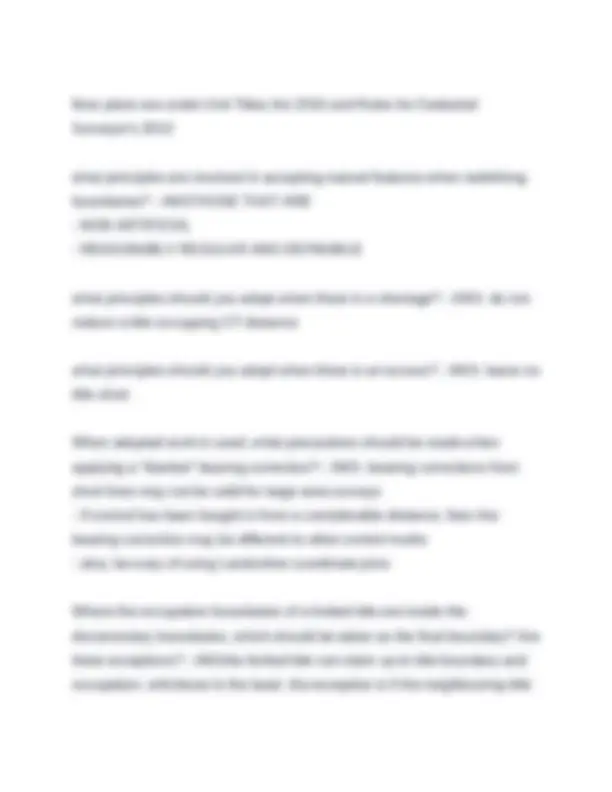Download SURV307 Exam Self-learning Test Bank. Latest Edition 2025-2026.Questions & Correct Answers and more Exams Survey Sampling Techniques in PDF only on Docsity!
SURV307 Exam Self-learning Test
Bank. Latest Edition 2025-2026.
Questions & Correct Verified Answers.
Graded A
- Describe how to extract survey data from an area of interest. - ANS1. This is done my using an XML from land online (Extensible Markup Language) 2.) This data is then exported to a secondary computer program such as 12d
- Describe the primary data holding agency that should be visited when undertaking a Cadastral Survey. - ANSThe primary data holding agency is Land Information New Zealand (LINZ) who operate LandOnline, the official spatial database containing all title and cadastral survey data in New Zealand. Other secondary sources include Quickmap and Terraview.
- Describe the process of transforming specific coordinates of marks and saving this information. - ANSCoordinates are transformed from one system to another using the Prepare Transformation utility under Tools. The coordinate system which is to be converted to must be defined. The appropriate layer is activated, and the relevant marks are selected. Once the desired marks are highlighted, the Add to Transformation utility under
Map Utilities is used. Once all marks are selected, return to the Prepare Transformation utility and run the transformation.
- During the first field visit on any job, the surveyor will generally locate an origin, carry out some traversing and tie to occupation and some old marks. What calculations should be carried out during this activity? - ANS-Confirm the reliability of the origin: 0.2+0.1/100m (Rule 7), ensuring the bearings close acceptably, and that the results match the bearings and distances from the parent plan or calculations. -Close the traverse, checking the field calculations and ensure misclosure is within tolerance.
- Explain why Party Walls should be 'fixed by survey' vs. crossleases which can be fixed by tape. - ANS- party walls must be fixed by survey because they form a physical boundary between two properties, and as they are related to easements, often have significance for maintenance and modification issues
- crossleases can be fixed by tape as they define the physical occupation within a lease area, generally for the purpose of defining a restrictive covenant. Party walls require 1cm accuracy while Cross lease measurements are only required to be good enough for plotting purposes.
- How are encroachments into adjacent properties addressed in unit plans? - ANS- displayed as 0.25mm pecked line on plan
- include the dimensions and position of the encroachment relative to the boundary
- List three types of calculations which will be useful. - ANS- calculating joins between non-adjacent trigs
- pre-calculating peg ties
- pre-coordinate a plot for field use (finder ties)
- On returning to the office the surveyor will need to carry out computations to complete the field work. How should the surveyor deal with any misclosures within the new traverse run? - ANS- if the errors within new traverse work are within tolerance, then adjust the blocks using Bowditch and distribute the misclosure through the traverse
- if the errors are out of tolerance, then isolate the error and then re- observe those legs of the traverse
- Once a surveyor has searched the data for a cadastral survey certain calculations should be carried out before starting field work. Why? - ANSCalculations should be carried out prior to field work commencing primarily to save time in the field. It's far easier and more convenient to do them in the office. You just need to be aware of over calculation in case things change.
- Understand the difference between CT and CFR - ANSCT = certificate of title = pre landonline CFR = computer freehold register = post landonline
- What are the differences between DCDB data and PEP data, and what population areas have which type, and what coordinate accuracies apply in each type? - ANSDCDB data is Digital Cadastral Data Base, and is
comprised of information digitised from survey office plans for all of New Zealand. Because of the digitising process accuracies tend to be relatively poor, with coordinate wobble of up to 1m in urban areas. PEP data is from the Populate Electronic Parcel project, and consists of the use of adopted boundary bearings and distance from approved plans, and the inclusion of new survey work as it became available. PEP was the first real incarnation of Landonline, using Least Squares Analysis to adjust the network, and topology fixing to ensure that boudnary nodes are linked to a minimum of two properties (no duplicate boundary lines). PEP areas tend to be urban NZ and highly productive rural lands, and have an accuracy of 0.04 + 0.01/100m.
- What are the factors to be resolved when receiving instructions for a Cadastral job? - ANSWhat does the client expect? What type of surveying work to be undertaken? Where/when will the work occur? How much the job will cost? Which legislation is to be used? Method of payment?
- What are the legislative requirements to obtain all possible data? - ANSThe requirements are set out in the Cadastral Survey Act 2002 , and require the surveyor to examine all relevant documents from the following sources: 1). Cadastral Survey Data and other info held by the Chief Executive
- What is Primary Source Material? - ANSPrimary Source Material is all of the information used by surveyors to undertake a boundary definition; field books, traverse sheets, plans, etc
- What is the difference between textual and spatial searching? - ANSTextual searching relies on a text based search (e.g. entering an appellation, street address, etc), while spatial searching is a graphical means of searching a map.
- What is the meaning of a statement that "S563 The following adopted boundary observations have dimensions that could not be verified by Landonline"? - ANSThis means that the adoptions which have been used were not added to Landonline during the PEP project. This does not necessarily mean the data is invalid, just that the information is not currently in Landonline.
- What is topology and topological fixing? - ANSTopology is the spatial relationship defined between two or more polygons. Topological fixing in a surveying sense is ensuring no duplicate boundaries arise through the requirement that a boundary nodes link a minimum of two parcels.
- What procedures would you adopt to locate flats if there were no reliable boundary monuments? - ANS- measure the position of the building in relation to any old fences or existing occupation
- tape around the building. check that the part distances sum to the measured total. this checks for any gross errors or modification of title structures
- measure occupation on neighbouring properties and across the road to confirm agreement with title dimensions
- When is it advisable to have a unit title survey? - ANS- when you want to make individual dwellings/units of separate ownership upon a single title. the units may be attached or detached and may consist of PU (principal units) or AU (auxillary units). common unit title scenarios are: apartments, townhouses etc.
- units within are individually defined and if they are not AU or PU they are common areas, which are most commonly managed by body corporate
- When using adoptions, does the old traverse information or old boundary information hold priority? Why? - ANSOLD TRAVERSE WORK as it has been tied in to the surrounding framework, while boundary marks are derived/placed from the traverse marks. Hence we will be working from the whole to the part. However it is important to recall that occupation and old marks found at the boundary take precedence. Old work in the vicinity should not be adopted until all marks have been thoroughly searched for.
- Why do surveyors want to tie their new work into the surrounding cadastral framework? - ANS- ties into parents plans, ensuring there are no gaps or overlaps in survey
flatplan/lease title not the land title, and hence is not recognising this as a valid land title
- If direct access is not possible to an object that needs a 3d "fix", what is important about bearing intersections and the angle of incidence? (common to both conventional instruments and reflectorless) - ANSoften a disagreement between neighbours means a refusal to access. first choice is reflectorless EDM. second choice is survey by intersection of azimuths and zenith distance. it is important that this is only done when it is neccessary. ensure a good geometry of intersection is acquired. 4 things to check before leaving final site visit - ANS- are pegs correct
- are all tolerances met?
- sufficient occupation collected (position, encroachment?)
- field diagram completed
- What would the survey requirements be in order for you to calculate a building height restriction for electrical conductors over a residential subdivision? - ANSEDM distance and bearing
- cadastral connections D.Ps C.Ts
- datum and benchmark
- ground levels along boundary or maybe even over entire site (know the TA DP)
- fix of either pylon for both vertical and horizontal position then using missing line for the wire
- then perform an intersection to find the low point of wire and height here as EDM not possible
After calculating pegging ties, what checks should be carried out? - ANS- check tolerances between new pegged positions and witness marks
- tolerances between PRMs and survey
- check the tolerances betweeen new pegs and existing pegs (survey tolerances) an excess or shortage is often encountered between adopted work or old work found on your modern fix or calc. what mathematics usually used to deal with this? - ANS- pro rate
- bowditch
- ray trace
- intersectino Be able to explain the role of the licensed cadastral surveyor in boundary surveys - ANSthe LCS operates in a quasi-judicial manner, making determinations of location of boundaries by implementing hierachy of evidence:
- natural boundaries
- monuments
- long standing occupation
- abuttals
- old plans
- calculations the decisions made by LCS about boundary determinations are impartial, irrespective of the client
Describe what documentary evidence may be useful when conducting a cadastral survey and what they may disclose - ANSIt may be useful to review old title plans, old survey plans, traverse sheets, field books or survey reports as they may include information as to what decisions and calculation were made. Other documents include Certificates of Title (pre- Landonline), Computer Freehold Register and other documents, i.e., Transfers, Liens, Caveats and covenants. The Surveyor's reputation may also need to be considered in some cases Describe what field evidence may be found and used for definition - ANS- old pegs
- old traverse marks
- the remains of the above
- natural boundaries
- old occupation
- oral evidence Explain how to determine whether old pegs are disturbed or not - ANSan old peg can be determined to be disturbed by checking:
- it looks appropriate for its age
- markings are out of place (i.e. lot numbers)
- if it does not appear true
- if it does not agree with calculations or potentially occupation etc. Explain the difference between a witness mark and a PRM by form & function. - ANSwitness mark - this is a traverse mark that references new
boundaries that are being established by survey work. it is a requirement that every new boundary peg must reference a witness mark (i.e. three pegs can use same witness mark). a witness mark must be durable, stable and last at least 10 years. PRM's - this is a survey mark that provides a ready origin for the next survey. TWO PRMS are required for any survey work that references a witness mark. a PRM must be durable, stable and last a minimum of 50 years. Explain the most common form of Party Wall. (there are 4 total) - ANS- The land under the wall is owned as tenants in common; each party has an undivided half share. This form is legally the most robust, but requires that the party wall be held in a second title which cannot be separated from the main title. Often more legal work/cost and more difficult for laypersons to understand.
- The party wall is subject to a crosslease easement agreement; each party has an easement over the adjoining property owner's physical portion of the wall.
- The party wall is subject to an easement, held by one party only.
- The party wall is divided longitudinally into two parts, each owned separately, with reciprocal easements (crosseasements). This is the most common type of party wall.
How has the use of GPS changed witness and traverse mark layout? How would this impact upon users confined to EDM total stations? - ANSGPS has changed witness and traverse marks being placed in areas that are suitable for GPS, for example in areas with good sky visibility and where multipath issues are reduced. However, this affects TS because this can neglect intervisibility of the marks. How would you dig for an old peg? - ANShave a hole of sufficient area, as coordinates may differ. remove material with care so to ensure that peg is not "flipped out" How would you handle a situation where there was an obstacle in the way or the ground was unstable when marking boundaries? - ANSin these circumstances, it is not a requirement that boundary marks be placed but it is good practice to place an offset. in the CSD, it should be described the obstacle and instability of ground, and the distances of boundary to occupation and offset If using GPS in 4 above, what factors should be considered? - ANS- GNSS observations reference the ellipsoid therefore are in terms of the official projection NZGD2000. Thus, only one mark is required to prove origin, two for checks and three for redundancy which allows any geodetic correction to be independently checked. it is important to note that if using GPS, you shouldnt adjust bearings to be in terms of old bearings/marks as this can throw out the bearings out from NZGD2000.
If you found the mark above in a decomposed condition, what would you do regarding maintenance of the cadastre? - ANSreinstatement would take place, reinstating it in its correct/original position this reinstatement needs to be DOCUMENTED If your metal detector goes flat, how would you find a traverse mark using information on the survey plan of the lot being subdivided? - ANSyou can use occupation diagrams, and use the offsets of significant features in the area. It also would indicate where the marks may be e.g. flush in seal, or depth below surface etc. in completing a defintion, a surveyor is often required to resort to using mathematical solution. what should the resulting definition be constrained by? - ANSthe definition should be constrained by higher evidences which have greater weight, along with accuracies available on previous surveys which calcs may be based. Is a survey always necessary to uplift Limitations from a Title? - ANSyesh Is the length of time a mark is in the ground a justifiable reason for not looking for a mark? - ANS- NO, if the mark is found (and proven reliable) then age shouldnt matter, that said if it has a longer age in the ground it has a longer line of evidence therefore could improve the STRENGTH of the survey further. the length of a mark in the ground can be up to 100+ years if placed well.
List five factors you may pick up by careful analysis of the data before going into the field - ANS- equipment and methods for the job -The occupation and state of the site.
- if bearing adjustment required
- whether marks are missing or not
- The class of the survey (defines the required accuracy). List the calculations needed before going into the field for final pegging - ANS- check all traverse work tolerances and reliability of adoptions
- tolerances of PRM and WM
- calc pegging ties List the two most important objectives of analysing survey data before commencing a job. - ANS- Establish origin of bearings and coordinates
- ensure that all old marks have been searched for Statutory requirements about locating old marks for origins and definitions?
- ANSRule 4.1(a) - marks must be oriented in terms of geodetic projection Rule 4.2 - any old marks that are used for boundary definition must be connected into cadastral network by at least one vector. Rule 6.1 - thorough searching for marks which may be used for boundary definition must take place, along with all evidence that may determine their correction position There are two common methods of calculating final pegging ties. What are they - ANS- double ties
- included angles
Under what circumstances may a ground mark be shorter than ideal? - ANSif there is concern that there are underground services present that may be disturbed Under what circumstances would a client need to "uplift" limitations from their title? - ANSif they wanted to increase tenure security, or conduct an action that is restricted by limitation e.g. it must be uplifted to subdivide Understand the differences between conventional freehold survey data input and unit title survey data input to Landonline - ANS- the main difference is for conventional freehold survey data you are trying to fix the boundary HOWEVER for unit title survey data you are trying to fix the dwelling itself. the dwelling is the boundary What are the different methods of presenting unit plan information in Landonline? - ANStraditional D15 form that has been in use from 1972
- all certificates on face of plan
- plan then scanned and submitted as Tif file or diagram to scale but certificates in different document What are the legislative requirements to put new work into Geodetic Datum? When is this feasible? What practical limits should be set? - ANS- The legislative requirements to put new work (coordinate and bearings) into


